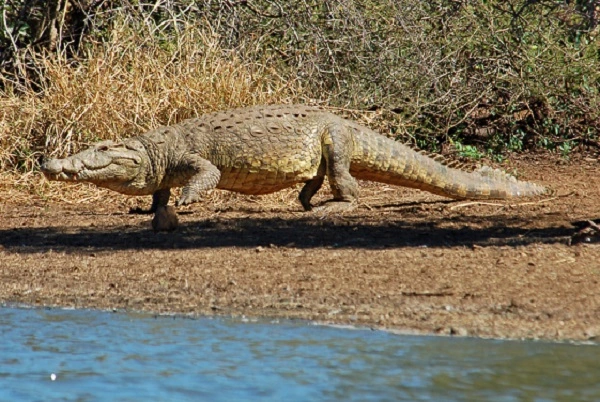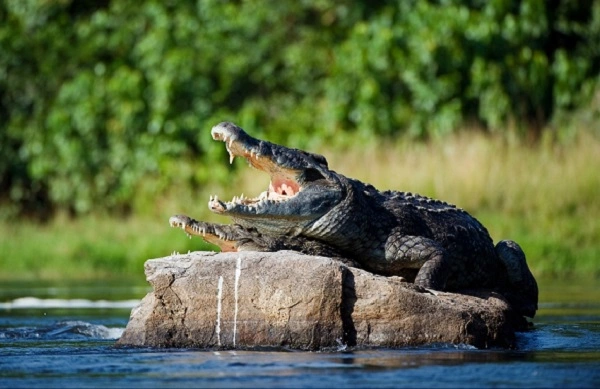The Nile crocodile (Crocodylus niloticus) is a large, apex predator found in freshwater habitats throughout sub-Saharan Africa. Considered one of the world’s deadliest animals, this reptile is known to attack and kill humans without provocation. Despite its aggressive demeanor, however, the Nile crocodile is an important part of many African ecosystems, and its population remains relatively stable. Learn more about this fascinating creature in today’s blog post!

Nile Crocodile Description
The Nile crocodile is a large crocodilian native to freshwater habitats in Africa, where it is present throughout the Nile Basin. Nile crocodiles are apex predators and consume a wide variety of prey. They are opportunistic hunters and will take any available animal they can catch. Nile crocodiles are ambush predators that can remain submerged for long periods of time before attacking their prey. They have been known to reach speeds of up to 35 km/h (22 mph) over short distances while attacking their prey on land. Adult Nile crocodiles typically grow to between 4 and 5 m (13 and 16 ft) in length, although some may reach 6 m (20 ft). They weigh an average of 500–1,000 kg (1,100–2,200 lb), with males averaging 1 tonne (2206 lb), although large specimens can weigh as much as 1.5 metric tons (3306 lb). Females are considerably smaller than males and normally do not exceed 3 m (9.8 ft) in length or 450 kg (992 lb) in weight. Nile crocodiles are sexually dimorphic with males growing much larger than females. The Nile crocodile is one of the most dangerous animals in Africa and is responsible for numerous human deaths each year. It has been estimated that Nile crocodiles kill 500 people per year making them more dangerous than sharks. Nile crocodiles are timid compared to other large crocodilians but if they feel threatened they will attack without hesitation. They have been known to attack boats and humans without provocation or warning. Nile crocodiles often bask on sandy beaches or basking rocks and logs near the water’s edge where they are particularly dangerous to humans who may mistake them for driftwood or logs. When approaching a basking Nile crocodile it is important to keep your distance and not to make any sudden movements as this may trigger an instinctive attack response from the reptile. If you must cross an area where Nile crocodiles are known to bask it is best to do so quickly and without stopping.
Nile Crocodile Habitat
Nile crocodiles are large freshwater reptiles that are native to Africa. The species is widely distributed across sub-Saharan Africa, occurring mostly in the Nile Basin, but also in Ethiopia, Somalia, Kenya, Uganda, Tanzania, Malawi, Zambia, Zimbabwe, Botswana, Namibia, and South Africa. They can grow up to 20 feet in length and weigh over 2,000 pounds. Nile crocodiles are apex predators and play an important role in the ecosystem. However, their habitat is under threat from human activity. Nile crocodiles live in swampy areas near rivers, lakes, and wetlands. They are found throughout sub-Saharan Africa, but the majority of the population is concentrated in the Nile Basin. The Nile Basin is home to over 90% of the world’s Nile crocodiles. Human activities, such as pollution, habitat destruction, and hunting, have dramatically reduced the number of Nile crocodiles. As a result, the Nile crocodile is listed as a threatened species. Conservation efforts are underway to protect this iconic species and its habitat.
Nile Crocodile Diet
Nile crocodiles are large, predatory reptiles that are native to Africa. They are the largest extant species of crocodile and can grow to lengths of up to 20 feet. Nile crocodiles are apex predators and their diet consists primarily of fish, but they will also consume birds, mammals, and reptiles. Their powerful jaws and sharp teeth allow them to easily dispatch their prey. Nile crocodiles typically hunt at night and they use their acute sense of smell to locate their prey. Once they have located their target, they will patiently wait for the right moment to strike. When they are ready to attack, they will launch themselves out of the water and grab their prey with their powerful jaws. The Nile crocodile is a feared predator and its diet reflects this.

Nile Crocodile Size
Nile Crocodiles are the largest reptiles in Africa, and can reach lengths of over 20 feet and weigh over a ton. They have gray-brown skin, with darker bands on the body and lighter spots on the belly. Nile Crocodiles are found throughout sub-Saharan Africa, in countries such as Sudan, Ethiopia, Kenya, Tanzania, Zambia, Zimbabwe, and South Africa. Nile Crocodiles typically inhabit freshwater rivers and lakes, but can also be found in brackish waters. These crocodiles are carnivores, and will eat almost any animal they can catch, including fish, turtles, birds, and mammals. Nile Crocodiles are notorious for being aggressive and dangerous to humans. Each year, these crocodiles are responsible for hundreds of human deaths. As a result, Nile Crocodiles are often feared and hunted by humans.
Nile Crocodile Lifespan
Nile crocodiles are one of the largest species of crocodiles, and they can live for a very long time. In fact, the average lifespan of a Nile crocodile is around 70 years. However, there have been reports of Nile crocodiles reaching an age of 100 years or more. Nile crocodiles are found in Africa, and they are known for being aggressive and dangerous animals. They are also very good swimmers, and they can hold their breath for up to an hour at a time. Nile crocodiles are hunted for their skin, which is used to make leather products. They are also sometimes kept as pets, although this is not recommended due to their aggressive nature.
Nile Crocodile Behavior
Nile crocodiles are large, predatory reptiles that are found throughout Africa. Adults can grow to be over 16 feet in length and weigh over a ton. Nile crocodiles are known for their aggressive behavior, and they have been known to attack and kill humans. Nile crocodiles typically live in freshwater habitats, such as rivers, lakes, and swamps. They are good swimmers and can remain underwater for up to an hour. Nile crocodiles are carnivores and will eat almost anything that they can catch, including fish, mammals, reptiles, and birds. Nile crocodiles typically ambush their prey and then drag it into the water to drown it. They will then tear the carcass apart with their powerful jaws and sharp teeth. Nile crocodiles are feared by many people, but they play an important role in the African ecosystem.
Nile Crocodile Speed
Nile Crocodiles are one of the fastest moving reptiles on the planet and can reach speeds of up to 18 miles per hour (mph) in short bursts. They are propelled by their powerful tails which make up about one third of their total body length. Nile Crocodiles can also move quite quickly through water, reaching speeds of around 7 mph. This surprising speed is due to their “hydrofoil” tails which act like a rudder, propelling them through the water. When Nile Crocodiles are running on land, they often use their tails as a counterbalance to help them turn quickly and move in a straight line. Their agility and speed make Nile Crocodiles very effective predators which is why they are one of the most feared animals in Africa.
Nile Crocodile Hunting
Nile crocodiles are among the largest and most dangerous predators in Africa. These massive reptiles can grow up to 20 feet in length and weigh over a ton, making them a formidable opponent for any would-be hunter. Nile crocodiles are found throughout sub-Saharan Africa, but the majority of hunting takes place in the Nile River basin. Despite their size and power, Nile crocodiles are relatively easy to kill, and their meat is considered a delicacy in many parts of Africa. As a result, Nile crocodile hunting is a popular pastime for many people in the region. While there are some risks involved, Nile crocodile hunting can be a fun and exciting way to experience the African wilderness.
Conclusion
The Nile crocodile is an imposing and dangerous creature, but it is also a remarkable animal that has played an important role in the history of humanity. We hope you have enjoyed learning about this fascinating reptile.
Frequently Asked Question


